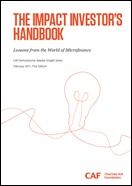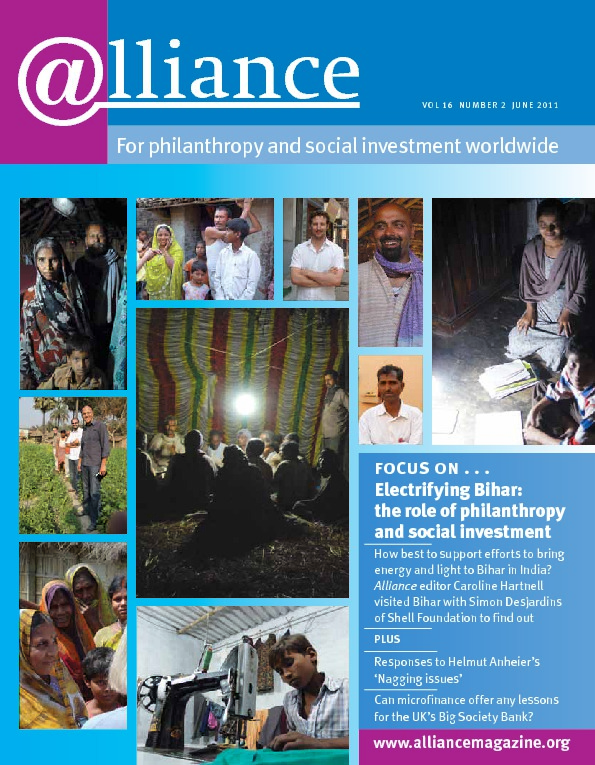The future of the social investment market in the UK is yet to be shaped. 2011 will be a pivotal year for building this market because of the arrival of the Big Society Bank – the new ‘central bank’ for providing wholesale financing to social finance intermediaries such as CAF Venturesome, Bridges Ventures, Social Finance Ltd, Triodos Bank, Charity Bank, Big Issue Invest, credit unions and microcredit lenders. No country has ever attempted to do this. That is why the UK must get this new institution right.
But already we are seeing underlying tensions emerge. These echo some of the previous debates that have influenced the development of the microfinance industry over the last 30 years. Many of the challenges faced by social investors today were successfully overcome by the pioneers of microfinance. For example, the soul searching about ‘mission drift’ in microfinance is reflected in the discussion about how to frame the mission of the Big Society Bank itself.
 CAF Venturesome’s Impact Investor’s Handbook examines the world of microfinance in order to see what lessons can be applied to the social investment market as it develops and how it can avoid some of the pitfalls that the microfinance industry has faced. These lessons are highly relevant to the Big Society Bank.
CAF Venturesome’s Impact Investor’s Handbook examines the world of microfinance in order to see what lessons can be applied to the social investment market as it develops and how it can avoid some of the pitfalls that the microfinance industry has faced. These lessons are highly relevant to the Big Society Bank.
Much of the debate about the Big Society Bank relates to the apparent assumption that it will function without subsidy. The UK social investment market is growing and increasingly diverse, but it is also fragile; social purpose organizations, both social enterprises and charities, have a range of financial needs.
While social enterprises are largely seen as financially sustainable entities that also create positive social impact, and largely funded from more commercial pools of capital, the financial needs of impact-first organizations, ie charities, and finance-first social enterprises are in fact very similar: capital to acquire assets, working capital and development capital. If the Big Society Bank is to meet these different needs, and to finance across the spectrums of risk and profitability evident in the social sector, then it will need to work to increase the flow of philanthropic capital, commercial capital, and capital seeking blended returns. Available evidence strongly suggests that the Bank will struggle to operate a fully commercial model.
The history of the microfinance industry shows visionary action from key early players and large flows of donor funds absorbing risk for early intermediary funds. Improvements in the absorptive capacity of microfinance organizations occurred as a result of the professionalization pressures of commercialization and extensive support poured into the enabling environment. Over time the risk premium on microfinance reduced as default rates proved low and repayments consistent.
 If the Bank pursues commercial returns, or seeks to leverage commercial investors to rapidly grow the capital available within the social investment market, it will be critical to guard against ‘mission drift’. A key lesson from the development of the microfinance industry is that investors need to ensure that sources of capital are appropriately matched to their social impact goals. In seeking more commercial sources of capital, it can become increasingly difficult to maintain focus on a social or charitable mission, particularly if doing so constrains financial returns to investors.
If the Bank pursues commercial returns, or seeks to leverage commercial investors to rapidly grow the capital available within the social investment market, it will be critical to guard against ‘mission drift’. A key lesson from the development of the microfinance industry is that investors need to ensure that sources of capital are appropriately matched to their social impact goals. In seeking more commercial sources of capital, it can become increasingly difficult to maintain focus on a social or charitable mission, particularly if doing so constrains financial returns to investors.
Furthermore, the risk with this is that many existing social ventures (charities, social enterprises or community groups) will not benefit as they are currently unable to generate sufficient profit to deliver the financial returns that commercial investors will require.
Another key lesson from microfinance is that the industry has to articulate to potential investors an unambiguous choice between speed of growth and depth of impact. The Big Society Bank’s mission is to catalyse the growth of a sustainable social investment market – this is fundamentally different from simply growing the volume of capital available. If speed of growth is prioritized over impact, this may threaten the very development of a sustainable social investment market that the strategy is intended to support. Ultimately, the Bank must focus on a long-term, strategic vision to avoid some of the pitfalls that the microfinance industry faced.
Paul Cheng is senior investment manager at CAF Venturesome and chair of the European Social Investment Taskforce. Email PCheng@cafonline.org
For more information
The Impact Investor’s Handbook, edited by Paul Cheng, is available for free download at http://www.venturesome.org





Comments (0)